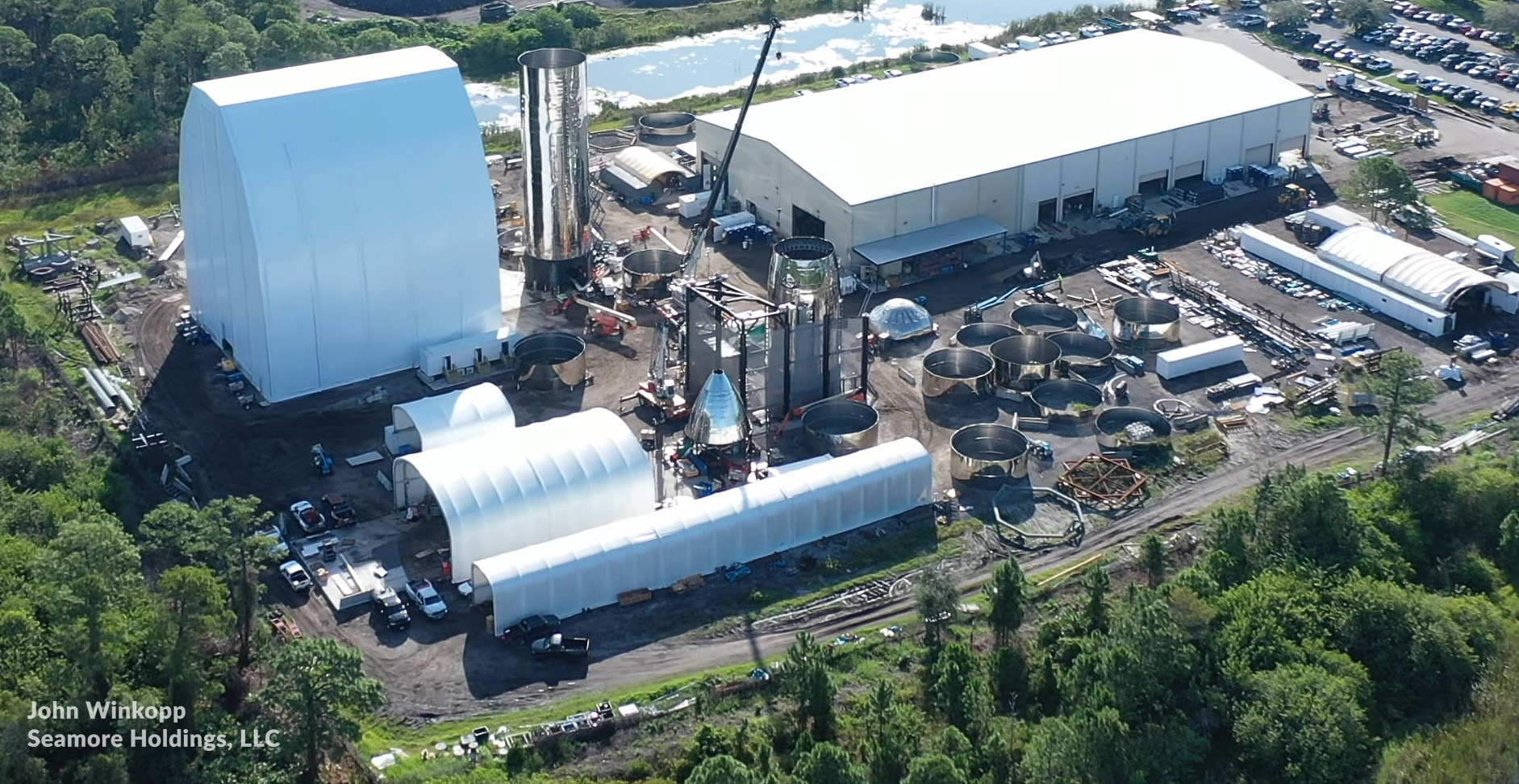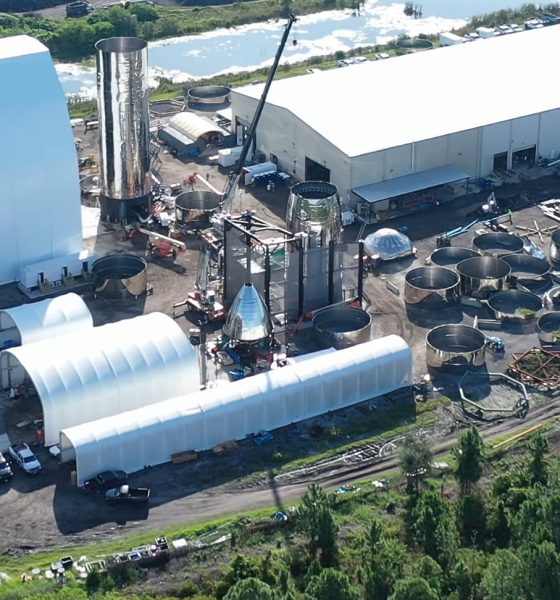

News
SpaceX's Texas Starship factory set to receive more parts from Florida
After successfully delivering Starship hardware and manufacturing tools to SpaceX’s Boca Chica, Texas rocket factory and launch facilities, the company has begun preparing a second load of parts to be shipped from Florida to Texas in the near future.
This is the latest chapter in a saga that began when SpaceX revealed that it would effectively pause its Florida Starship manufacturing operations and reassign most of its affected employees. Since SpaceX’s early-December confirmation, the company’s Cocoa, Florida Starship production hub has been more or less at a standstill, only interrupted once and awhile by efforts to either scrap hardware that is no longer needed or send it to Texas, where SpaceX has redoubled efforts to build the next series of Starship prototypes.
Teams in Florida are still working tirelessly to construct a massive Starship launch mount at Pad 39A believed to be capable of supporting full-scale Starship and Super Heavy static fires and launches, confirmation that SpaceX is likely only temporarily halting Starship production in the region. Nevertheless, the focus is now unequivocally on SpaceX’s Boca Chica facilities, where the company is rapidly building and expanding manufacturing facilities and constructing the next full-scale Starship prototype (SN01).
Although manufacturing operations have been paused in Florida, the existing Cocoa facility still has a huge amount of Starship hardware strewn about, most of which appears to be bound for scrapyards. Some of that hardware and infrastructure, however, can be salvaged and used elsewhere by SpaceX, and that is exactly what the company is now doing.
Most recently, SpaceX loaded transport ship GO Discovery with two giant steel stands and a completed Starship dome and transported that hardware from Port Canaveral, Florida to Port of Brownsville in early-December 2019. After arriving, SpaceX moved the rocket parts and infrastructure by road to its Boca Chica facilities, where they have since been stored until they’re needed.

At the moment, the almost-finished Starship Mk2 prototype remains at SpaceX’s Cocoa factory in three giant pieces – a cylindrical tank and engine section, the start of a curved nose section, and the tip of that nose section. It remains to be seen what the fate of those rocket parts is, as much of the structure could theoretically be sent to Texas to expedite Starship SN01 production and assembly. However, the utility of those parts is likely almost entirely dependent on their quality and the design and fabrication delta between them and whatever SpaceX has in mind for the next phase of prototypes.
SpaceX continues to develop Starship in largely the same way it worked on Falcon 9 booster landings, beginning with a minimum viable product (Grasshopper/Starhopper) and gradually improving the test hardware into something much more reminiscent of the real deal (F9R/Starship Mk1, Mk2). Ultimately, all the experience gained and lessons learned from building and flying those increasingly more complex prototypes is merged with true orbital-class flight hardware.
It appears that SpaceX (or at least CEO Elon Musk) believes that the company may have already learned enough from Starhopper and Starship Mk1/Mk2 to graduate directly to some form of serial production – implied by his statement that the next Texas prototype will now be known as Starship SN01. Formerly Starship Mk3, Starship SN01 will be built with an array of refined or fully-new production and assembly processes, hopefully resulting in a prototype that is significantly more refined than Starship Mk1, which is believed to have been intentionally destroyed during pressure testing in November 2019.
In line with that strategy, SpaceX is preparing to ship more upgraded Starship hardware and infrastructure from Florida to Texas.
Based on photos taken in the last few days by local photographer and observer John Winkopp, GO Discovery’s next shipment will include a number of rolls of stainless steel stock, another steel stand for Starship ring assembly, and parts of another unfinished Starship tank dome.
Altogether, it’s possible that Starship SN01 assembly will end up taking far less time than Starship Mk1 or Mk2. Musk believes that that new and improved Starship prototype could be ready for flight testing as early as February or March 2020.
Check out Teslarati’s Marketplace! We offer Tesla accessories, including for the Tesla Cybertruck and Tesla Model 3.

News
Tesla FSD fleet is nearing 7 billion total miles, including 2.5 billion city miles
As can be seen on Tesla’s official FSD webpage, vehicles equipped with the system have now navigated over 6.99 billion miles.

Tesla’s Full Self-Driving (Supervised) fleet is closing in on almost 7 billion total miles driven, as per data posted by the company on its official FSD webpage.
These figures hint at the massive scale of data fueling Tesla’s rapid FSD improvements, which have been quite notable as of late.
FSD mileage milestones
As can be seen on Tesla’s official FSD webpage, vehicles equipped with the system have now navigated over 6.99 billion miles. Tesla owner and avid FSD tester Whole Mars Catalog also shared a screenshot indicating that from the nearly 7 billion miles traveled by the FSD fleet, more than 2.5 billion miles were driven inside cities.
City miles are particularly valuable for complex urban scenarios like unprotected turns, pedestrian interactions, and traffic lights. This is also the difference-maker for FSD, as only complex solutions, such as Waymo’s self-driving taxis, operate similarly on inner-city streets. And even then, incidents such as the San Francisco blackouts have proven challenging for sensor-rich vehicles like Waymos.
Tesla’s data edge
Tesla has a number of advantages in the autonomous vehicle sector, one of which is the size of its fleet and the number of vehicles training FSD on real-world roads. Tesla’s nearly 7 billion FSD miles then allow the company to roll out updates that make its vehicles behave like they are being driven by experienced drivers, even if they are operating on their own.
So notable are Tesla’s improvements to FSD that NVIDIA Director of Robotics Jim Fan, after experiencing FSD v14, noted that the system is the first AI that passes what he described as a “Physical Turing Test.”
“Despite knowing exactly how robot learning works, I still find it magical watching the steering wheel turn by itself. First it feels surreal, next it becomes routine. Then, like the smartphone, taking it away actively hurts. This is how humanity gets rewired and glued to god-like technologies,” Fan wrote in a post on X.
News
Tesla starts showing how FSD will change lives in Europe
Local officials tested the system on narrow country roads and were impressed by FSD’s smooth, human-like driving, with some calling the service a game-changer for everyday life in areas that are far from urban centers.

Tesla has launched Europe’s first public shuttle service using Full Self-Driving (Supervised) in the rural Eifelkreis Bitburg-Prüm region of Germany, demonstrating how the technology can restore independence and mobility for people who struggle with limited transport options.
Local officials tested the system on narrow country roads and were impressed by FSD’s smooth, human-like driving, with some calling the service a game-changer for everyday life in areas that are far from urban centers.
Officials see real impact on rural residents
Arzfeld Mayor Johannes Kuhl and District Administrator Andreas Kruppert personally tested the Tesla shuttle service. This allowed them to see just how well FSD navigated winding lanes and rural roads confidently. Kruppert said, “Autonomous driving sounds like science fiction to many, but we simply see here that it works totally well in rural regions too.” Kuhl, for his part, also noted that FSD “feels like a very experienced driver.”
The pilot complements the area’s “Citizen Bus” program, which provides on-demand rides for elderly residents who can no longer drive themselves. Tesla Europe shared a video of a demonstration of the service, highlighting how FSD gives people their freedom back, even in places where public transport is not as prevalent.
What the Ministry for Economic Affairs and Transport says
Rhineland-Palatinate’s Minister Daniela Schmitt supported the project, praising the collaboration that made this “first of its kind in Europe” possible. As per the ministry, the rural rollout for the service shows FSD’s potential beyond major cities, and it delivers tangible benefits like grocery runs, doctor visits, and social connections for isolated residents.
“Reliable and flexible mobility is especially vital in rural areas. With the launch of a shuttle service using self-driving vehicles (FSD supervised) by Tesla in the Eifelkreis Bitburg-Prüm, an innovative pilot project is now getting underway that complements local community bus services. It is the first project of its kind in Europe.
“The result is a real gain for rural mobility: greater accessibility, more flexibility and tangible benefits for everyday life. A strong signal for innovation, cooperation and future-oriented mobility beyond urban centers,” the ministry wrote in a LinkedIn post.
News
Tesla China quietly posts Robotaxi-related job listing
Tesla China is currently seeking a Low Voltage Electrical Engineer to work on circuit board design for the company’s autonomous vehicles.

Tesla has posted a new job listing in Shanghai explicitly tied to its Robotaxi program, fueling speculation that the company is preparing to launch its dedicated autonomous ride-hailing service in China.
As noted in the listing, Tesla China is currently seeking a Low Voltage Electrical Engineer to work on circuit board design for the company’s autonomous vehicles.
Robotaxi-specific role
The listing, which was shared on social media platform X by industry watcher @tslaming, suggested that Tesla China is looking to fill the role urgently. The job listing itself specifically mentions that the person hired for the role will be working on the Low Voltage Hardware team, which would design the circuit boards that would serve as the nervous system of the Robotaxi.
Key tasks for the role, as indicated in the job listing, include collaboration with PCB layout, firmware, mechanical, program management, and validation teams, among other responsibilities. The role is based in Shanghai.
China Robotaxi launch
China represents a massive potential market for robotaxis, with its dense urban centers and supportive policies in select cities. Tesla has limited permission to roll out FSD in the country, though despite this, its vehicles have been hailed as among the best in the market when it comes to autonomous features. So far, at least, it appears that China supports Tesla’s FSD and Robotaxi rollout.
This was hinted at in November, when Tesla brought the Cybercab to the 8th China International Import Expo (CIIE) in Shanghai, marking the first time that the autonomous two-seater was brought to the Asia-Pacific region. The vehicle, despite not having a release date in China, received a significant amount of interest among the event’s attendees.








